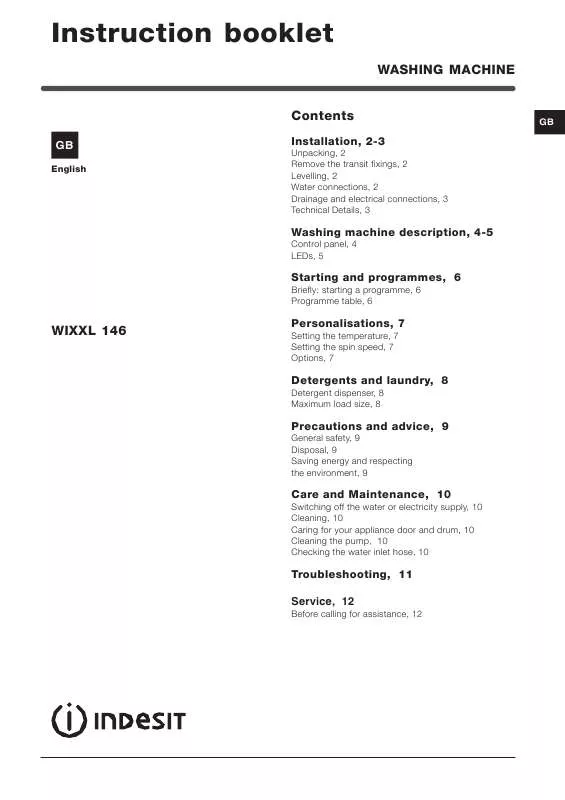Detailed instructions for use are in the User's Guide.
[. . . ] Instruction booklet
WASHING MACHINE Contents
GB
English
GB
Installation, 2-3
Unpacking, 2 Remove the transit fixings, 2 Levelling, 2 Water connections, 2 Drainage and electrical connections, 3 Technical Details, 3
Washing machine description, 4-5
Control panel, 4 LEDs, 5
Starting and programmes, 6
Briefly: starting a programme, 6 Programme table, 6
WIXXL 146
Personalisations, 7
Setting the temperature, 7 Setting the spin speed, 7 Options, 7
Detergents and laundry, 8
Detergent dispenser, 8 Maximum load size, 8
Precautions and advice, 9
General safety, 9 Disposal, 9 Saving energy and respecting the environment, 9
Care and Maintenance, 10
Switching off the water or electricity supply, 10 Cleaning, 10 Caring for your appliance door and drum, 10 Cleaning the pump, 10 Checking the water inlet hose, 10
Troubleshooting, 11 Service, 12
Before calling for assistance, 12
1
Installation
Keep this instruction manual in a safe place for future reference. Should the appliance be sold, transferred or moved, make sure the instruction manual accompanies the washing machine to inform the new owner as to its operation and features. Read these instructions carefully: they contain vital information on installation, use and safety.
GB
Levelling
Your machine will be noisy if the two front feet are not adjusted so that the machine stands firm and level. The machine should be levelled from side to side and from front to back. [. . . ] Delay Timer
All
For washing a smaller load. Mini Load This option reduces the amount of creasing on fabrics, making them easier to iron.
1, 2, 3, 4, 5 Rinse cycle
3, 4, 5, 6, 7, 8, 9, 10, Rinse cycle
Easy Iron
Increases the efficiency of the rinse. Extra Rinse
Recommended when the appliance has a full load or with large quantities of detergent.
1, 2, 3, 4, 5, 8, 9, 10, 12, 13 Rinse cycle
7
Detergents and Laundry
Detergent dispenser
!Do not put any items into the drawer, other than detergents designed to be released from the drawer, as they may cause damage or blockage. Maximum 200 ml powder or 100 ml liquid 2. Maximum 400 ml powder or 200 ml liquid 3. 1 1 1 1 1 sheet 400-500g pillow case 150-200g tablecloth 400-500g bathrobe 900-1200g towel 150-250g
GB
1 2 3
Dispensing powder detergent To achieve the best wash results the manufacturer's recommended amount of detergent should be measured and added to the main detergent compartment. Dispensing liquid detergent We recommend the use of a detergent dosing ball, as provided by your detergent manufacturer. Adding fabric conditioner Pour the recommended amount of fabric conditioner into the compartment. Pre-wash (Programme 1) When selecting programme 1 add detergent to both the pre-wash and the main wash compartment. Do not use in drum dosing devices with pre-wash programme 1.
Maximum load size
· Divide your laundry according to: - the type of fabric/the symbol on the label. - the colours: separate coloured garments from whites. · Empty all pockets and check for loose buttons. · Do not exceed the weight limits stated below, which refer to the weight when dry: Sturdy fabrics : max. DO NOT overload the machine as this could result in reduced performance.
8
Precautions and advice
!The machine was designed and built in compliance with the applicable international safety regulations. The following information is provided for your safety and should consequently be read carefully. · The pre-wash cycle is only necessary on extremely soiled garments. Avoiding it will save on detergent, time, water and between 5 and 15% energy. · Treating stains with a stain remover or leaving them to soak before washing will cut down the need to wash them at high temperatures. A programme at 60°C instead of 90°C or one at 40°C instead of 60°C will save up to 50% on energy. · Use the correct quantity of detergent, depending on the water hardness, how soiled the garments are and the amount of laundry you have, to avoid wastage and to protect the environment: despite being biodegradable, detergents do contain ingredients that alter the natural balance of the environment. [. . . ] · The wall drainage system doesn't have a breather pipe. If the problem persists even after these checks, turn off the water tap, switch the appliance off and call for Assistance. If the dwelling is on one of the upper floors of a building, there may be drain trap problems causing the washing machine to load and unload water continuously. In order to avoid such an inconvenience, special anti-drain trap valves are available in shops. [. . . ]


